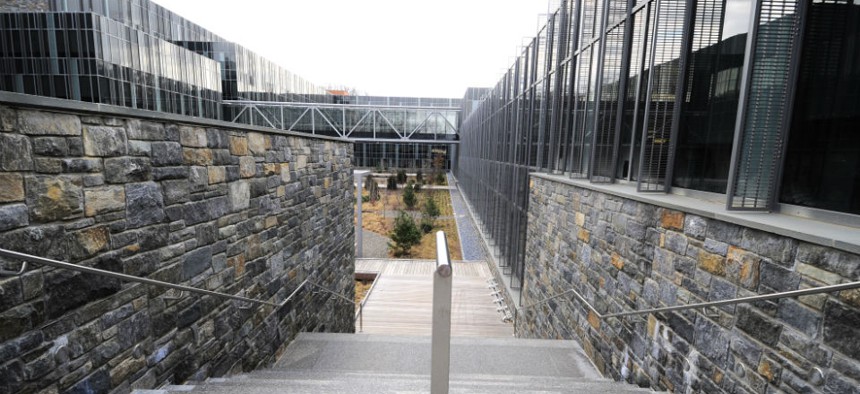
The Coast Guard is the only agency that has moved to the new location so far. Coline Sperling / Coast Guard file photo
Scaled-Back DHS Headquarters Plan Would Squeeze 3,000 More People Into the Same Space
Flexible workplace strategies would help accommodate 17,000 employees in an area originally planned for 14,000.
Tempers flared last September at a House hearing on cost overruns and construction delays in the Homeland Security Department’s near-decade-long push to consolidate its headquarters on the Southeast Washington campus of the old St. Elizabeths mental hospital.
But early this month, in documents accompanying President Obama’s fiscal 2016 budget request, the General Services Administration described an “enhanced,” or scaled-back plan, on which it has been working with Homeland Security for a year.
The problems with the massive project of moving 50 subunits emerged in a Government Accountability Office report, which criticized GSA and DHS for adding $1 billion to the price tag since 2006 and lengthening the time frame by 10 years. Some in Congress derided the project for overly-opulent architecture and threatened to pull the plug. So far only the Coast Guard has moved to the new location.
The rethought plan “proposes to save money by reducing overall construction at St. Elizabeths and the space requirements at other locations,” said GSA spokeswoman Kamara Jones, in a statement. “Improved space standards and flexible workplace strategies mean DHS will be able to accommodate 17,000 employees in a space originally planned for 14,000.”
GSA’s new request for nearly $380 million this year would save $800 million over the existing plan and complete the job in 2021 rather than 2026. That would bring to the total cost to $3.7 billion between the two agencies, with GSA assuming two-thirds of the cost. Besides going through the congressional budget process, the Enhanced Plan would also have to be reviewed and approved by the National Capital Planning Commission and the Commission of Fine Arts.
"The Enhanced Plan developed by DHS and GSA proposes to save money by reducing overall construction at St. Elizabeths and the space requirements at other locations," said DHS spokeswoman Ginette Magana. "As dependent upon funding, DHS anticipates being able to accommodate additional employees beyond our original estimate."
One key provision in the new strategy would be moving the Federal Emergency Management Agency from its current headquarters on C Street Southwest in Washington to a different part of St. Elizabeths than originally planned. “Increasing the campus population on West Campus would allow for additional government entities to be housed on the site, one of which would be FEMA,” the GSA said. “If the Enhanced Plan is executed as proposed, further planning will occur for the use of the FEMA site on East Campus.”
GSA arrived at its proposed savings by shrinking space needs, “working with DHS to adopt improved space standards and implement flexible workplace strategies,” the spokeswoman said. “The Enhanced Plan proposes a utilization rate of 155 or fewer usable square feet per person, down from 230 usable square feet per person in the original plan.”
With a new construction prospectus, GSA and DHS are continuing work at St. Elizabeths that includes perimeter security, construction of an access road and new interchange, design of future phases and historical preservation requirements for the West Campus, a 176–acre National Historic Landmark that includes 61 existing buildings.
Reaction to the enhanced plan by House Homeland Security Committee Chairman Rep. Michael McCaul, R-Texas, was positive, according to a statement he gave The Washington Post.
A more skeptical response came from Rep. Jeff Duncan, R-S.C., chairman of the Homeland Security Oversight and Management Efficiency Subcommittee. In a statement to Government Executive, Duncan cited a January 2014 House majority staff report stating that a comprehensive reassessment of the plan at St. Elizabeths was needed. “Mismanagement and inefficiency at DHS’ headquarters project has wasted millions of taxpayer dollars,” he said. “I am pleased to see that the department has a new plan to utilize the space at St. Elizabeths and cut wasteful spending, all in a timely fashion, but how this plan is implemented will be the true test. I will continue to monitor this process closely and work with my colleagues in ensuring that more taxpayer dollars are not wasted.”
Rep. John Mica, R-Fla., a longtime critic who serves on the House Oversight and Government Reform Committee, went further. “I remain strongly opposed to spending any federal funds on construction of a DHS Taj Mahal,” he told Government Executive. “Congress should be downsizing this dysfunctional agency and correcting the big mistake we made after 9/11. Republicans need to reshape this monstrous agency, leasing as little space, some of it outside Washington, as possible or occupying vacant federal property.”
NEXT STORY: A Healthy Menu Makeover for Food Trucks







